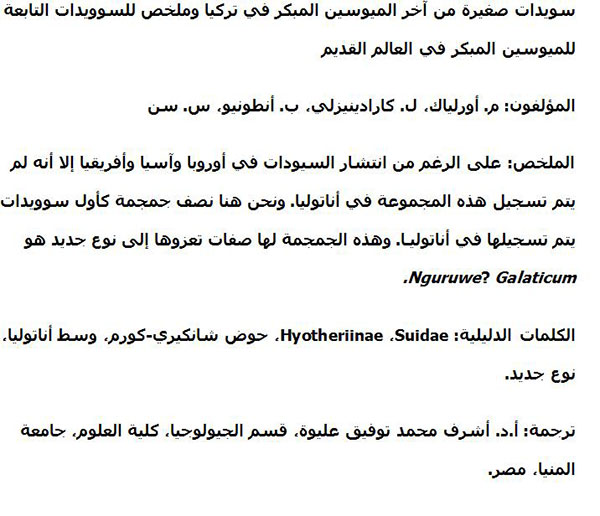Plain Language Abstract
Fossil remains of small pigs from Turkey (17-18 million years old) and a short overview of coeval small pigs in Eurasia and Africa. Extinct representatives of what we know today as pigs and peccaries were abundant in Europe, Asia, and Africa during the early Miocene between 17 and 18 million years ago. Strikingly, despite a rich fossil record at the Old World scale, no early Miocene pigs are known thus far from Anatolia in Turkey, a region located at the crossroads between Africa, Arabia, Asia, and Europe. Here we describe a fragmentary fossil cranium and an isolated milk tooth of small pigs from the fossiliferous locality of Şemsettin in north Central Anatolia. These fossil remains document the first pigs ever recorded in the early Miocene of Turkey. Both remains are attributed to the suid subfamily Hyotheriinae. The fragmentary cranium presents previously unknown morphology and is attributed to a new species, Nguruwe? galaticum sp. nov. The isolated milk tooth, of much smaller size, is thought to belong to another (unidentified) species of the hyotheriine subfamily. The new species Nguruwe? galaticum sp. nov. shows equal affinity with Asiatic and African Hyotheriinae.
Glossary
Suidae: family of mammals including what we know today as "pigs"
Suoidea: family of mammals including what we know today as "pigs" and "peccaries"
early Miocene: a sub-epoch of the Miocene Epoch made up of two stages: the Aquitanian (from 23.03 to 20.4 million years ago) and Burdigalian stages (from 20.4 to 16 million years ago).
Resumen en Español
Pequeños suidos hyotheriinos (Mammalia, Artiodactyla) del Mioceno temprano tardío de Turquía y un breve resumen de los suoides del Viejo Mundo
Los suoides son componentes conspicuos de las faunas del Mioceno temprano tardío en Europa, Asia y África. Sorprendentemente, a pesar de la riqueza de su registro fósil a escala del Viejo Mundo, no se conocían aún restos de suoides de edad miocena temprana provenientes de Anatolia, una región ubicada en el cruce entre África, Arabia, Asia y Europa. Aquí se describen un cráneo fragmentario, preservando mayormente el paladar y un dp4 de pequeños suidos de la localidad Şemsettin en la Cuenca Çankiri-Çorum, Anatolia Central septentrional. Estos restos son atribuidos a la subfamilia Hyotheriinae. El cráneo fragmentario presenta una combinación original de caracteres y es atribuido a Nguruwe? galaticum sp. nov. El dp4 aislado, mucho más pequeño, se atribuye aquí a otro taxón hyotheriino de género y especie indeterminados. Nguruwe? galaticum sp. nov. muestra igual afinidad con ambos Hyotheriinae asiáticos y africanos.
Palabras clave: Suidae; Hyotheriinae; Cuenca Çankiri-Çorum; Anatolia Central; especie nueva
Traducción: Diana Elizabeth Fernández
Résumé en Français
Petits suidés hyotheriinés (Mammalia, Artiodactyla) du Miocène ancien tardif de Turquie et une brève synthèse des petits suoïdes du Miocène ancien de l'Ancien Monde
Les suoïdes sont des éléments remarquables des faunes du Miocène ancien tardif d'Europe, d'Asie, et d'Afrique. De manière frappante, malgré un registre fossile riche à l'échelle de l'Ancien Monde, aucun reste de suoïdes du Miocène ancien n'était jusqu'à présent connu en Anatolie, une région située au carrefour entre l'Afrique, la péninsule arabique, l'Asie, et l'Europe. Nous décrivons dans cet article un crâne fragmentaire, préservant principalement le palais, et une dp4 de petits suidés provenant de la localité Şemsettin dans le bassin de Çankiri-Çorum, au nord de l'Anatolie centrale. Ces restes documentent les premiers suoïdes jamais découverts dans le Miocène ancien de Turquie. Ces deux spécimens sont attribués à la sous-famille Hyotheriinae. Le crâne fragmentaire présente une combinaison originale de caractères et est attribué à Nguruwe? galaticum sp. nov. La dp4 isolée, de taille bien plus réduite, est ici attribuée à un autre taxon de hyotheriiné dont le genre et l'espèce sont indéterminés. Nguruwe? galaticum sp. nov. présente autant d'affinités avec les Hyotheriinae d'Asie qu'avec ceux d'Afrique.
Mots-clés : Suidae ; Hyotheriinae ; bassin de Çankiri-Çorum ; Anatolie centrale ; nouvelle espèce
Translator: Antoine Souron
Deutsche Zusammenfassung
Kleine hyotheriine Suiden (Mammalia, Artiodactyla) aus dem späten Früh-Miozän der Türkei und eine kurze Übersicht über die kleinen Suiden aus dem frühen Miozän der Alten Welt
Suiden sind auffällige Elemente des späten Früh-Miozäns von Europa, Asien und Afrika. Auffälligerweise sind trotz des reichhaltigen Fossilrekords der Alten Welt bis jetzt keine Funde von Suiden aus dem frühen Miozän von Anatolien bekannt, einer Region an der Kreuzung zwischen Afrika, Arabien, Asien und Europa. Hier beschreiben wir ein fragmentarisches Cranium, das hauptsächlich aus dem Palatinum besteht und einen dp4 von einem kleinen Suiden aus der Şemsettin-Lokalität im Çankiri-Çorum Becken, nördliches Zentralanatolien. Diese Überreste dokumentieren die ersten Suiden die jemals aus dem Frühen Miozän der Türkei nachgewiesen wurden. Beide Überreste werden der Subfamilie Hyotheriinae zugeschrieben. Das fragmentarische Cranium stellt eine ursprüngliche Merkmalskombination dar und wird Nguruwe? galaticum sp. nov zugeschrieben. Der viel kleinere isolierte dp4 wird hier einem anderen hyotheriinen Taxon von unbestimmter Gattung und Art zugeschrieben. Nguruwe? galaticum sp. nov. zeigt gleichviele Gemeinsamkeiten mit sowohl den asiatischen als auch den afrikanischen Hyotheriinae.
Schlüsselwörter: Suidae; Hyotheriinae; Çankiri-Çorum Becken; Zentralanatolien; neue Art
Translator: Eva Gebauer
Arabic

Translator: Ashraf M.T. Elewa

